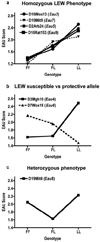Common genetic determinants of uveitis shared with other autoimmune disorders
- PMID: 18453595
- PMCID: PMC2493541
- DOI: 10.4049/jimmunol.180.10.6751
Common genetic determinants of uveitis shared with other autoimmune disorders
Abstract
Uveitis is a complex multifactorial autoimmune disease of the eye characterized by inflammation of the uvea and retina, degeneration of the retina, and blindness in genetically predisposed patients. Using the rat model of experimental autoimmune uveitis (EAU), we previously identified three quantitative trait loci (QTL) associated with EAU on rat chromosomes 4, 12, and 10 (Eau1, Eau2, and Eau3). The primary goal of the current study is to delineate additional non-MHC chromosomal regions that control susceptibility to EAU, and to identify any QTLs that overlap with the QTLs of other autoimmune diseases. Using a set of informative microsatellite markers and F(2) generations of resistant and susceptible MHC class II-matched rat strains (F344 and LEW), we have identified several new significant or suggestive QTLs on rat chromosomes 2, 3, 7, 10, and 19 that control susceptibility to EAU. A protective allele was identified in the susceptible LEW strain in the Eau5 locus at D7Wox18, and epistatic interactions between QTLs were found to influence the severity of disease. The newly identified regions (Eau4 through Eau9) colocalize with the genetic determinants of other autoimmune disease models, and to disease-regulating syntenic regions identified in autoimmune patients on human chromosomes 4q21-31, 5q31-33, 16q22-24, 17p11-q12, 20q11-13, and 22q12-13. Our results suggest that uveitis shares some of the pathogenic mechanisms associated with other autoimmune diseases, and lends support to the "common gene, common pathway" hypothesis for autoimmune disorders.
Figures


Similar articles
-
Differentially expressed genes in MHC-compatible rat strains that are susceptible or resistant to experimental autoimmune uveitis.Invest Ophthalmol Vis Sci. 2008 May;49(5):1957-70. doi: 10.1167/iovs.07-1295. Epub 2008 Feb 15. Invest Ophthalmol Vis Sci. 2008. PMID: 18281616 Free PMC article.
-
Identification of genomic regions controlling experimental autoimmune uveoretinitis in rats.Int Immunol. 1999 Apr;11(4):529-34. doi: 10.1093/intimm/11.4.529. Int Immunol. 1999. PMID: 10323205
-
Regulation of experimental autoimmune uveitis in rats--separation of MHC and non-MHC gene effects.Clin Exp Immunol. 1991 Dec;86(3):419-25. doi: 10.1111/j.1365-2249.1991.tb02947.x. Clin Exp Immunol. 1991. PMID: 1747950 Free PMC article.
-
Susceptibility to autoimmune disease and drug addiction in inbred rats. Are there mechanistic factors in common related to abnormalities in hypothalamic-pituitary-adrenal axis and stress response function?Ann N Y Acad Sci. 2000;917:784-96. doi: 10.1111/j.1749-6632.2000.tb05444.x. Ann N Y Acad Sci. 2000. PMID: 11268408 Review.
-
Immunogenetic aspects of clinical and experimental uveitis.Reg Immunol. 1992 Sep-Oct;4(5):321-30. Reg Immunol. 1992. PMID: 1290750 Review.
Cited by
-
Differentially expressed genes in MHC-compatible rat strains that are susceptible or resistant to experimental autoimmune uveitis.Invest Ophthalmol Vis Sci. 2008 May;49(5):1957-70. doi: 10.1167/iovs.07-1295. Epub 2008 Feb 15. Invest Ophthalmol Vis Sci. 2008. PMID: 18281616 Free PMC article.
-
Direct identification of rat iNKT cells reveals remarkable similarities to human iNKT cells and a profound deficiency in LEW rats.Eur J Immunol. 2013 Feb;43(2):404-15. doi: 10.1002/eji.201242565. Epub 2012 Dec 26. Eur J Immunol. 2013. PMID: 23165932 Free PMC article.
-
Understanding autoimmune uveitis through animal models. The Friedenwald Lecture.Invest Ophthalmol Vis Sci. 2011 Mar 30;52(3):1872-9. doi: 10.1167/iovs.10-6909. Print 2011 Mar. Invest Ophthalmol Vis Sci. 2011. PMID: 21450922 Free PMC article. No abstract available.
-
Lack of association between the protein tyrosine phosphatase non-receptor type 22 R263Q and R620W functional genetic variants and endogenous non-anterior uveitis.Mol Vis. 2013;19:638-43. Epub 2013 Mar 20. Mol Vis. 2013. PMID: 23559857 Free PMC article.
-
No evidence of association between common autoimmunity STAT4 and IL23R risk polymorphisms and non-anterior uveitis.PLoS One. 2013 Nov 29;8(11):e72892. doi: 10.1371/journal.pone.0072892. eCollection 2013. PLoS One. 2013. PMID: 24312163 Free PMC article.
References
-
- Nussenblatt RB. The natural history of uveitis. Int. Ophthalmol. 1990;14:303–308. - PubMed
-
- Caspi RR, et al. Th1 and Th2 responses in pathogenesis and regulation of experimental autoimmune uveoretinitis. Int. Rev. Immunol. 2002;21:197–208. - PubMed
-
- Pennesi G, Caspi RR, et al. Genetic control of susceptibility in clinical and experimental uveitis. Int. Rev. Immunol. 2002;21:67–88. - PubMed
-
- Martin TM, Kurz DE, Rosenbaum JT, et al. Genetics of uveitis. Ophthalmol. Clin. North. Am. 2003;16:555–565. - PubMed
-
- Mizuki N, Ota M, Katsuyama Y, Yabuki K, Ando H, Shiina T, Palimeris GD, Kaklamani E, Ito D, Ohno S, Inoko H, et al. Sequencing-based typing of HLA-B*51 alleles and the significant association of HLA-B*5101 and -B*5108 with Behcet's disease in Greek patients. Tissue Antigens. 2002;59:118–121. - PubMed
Publication types
MeSH terms
Grants and funding
LinkOut - more resources
Full Text Sources
Medical
Research Materials
Miscellaneous

